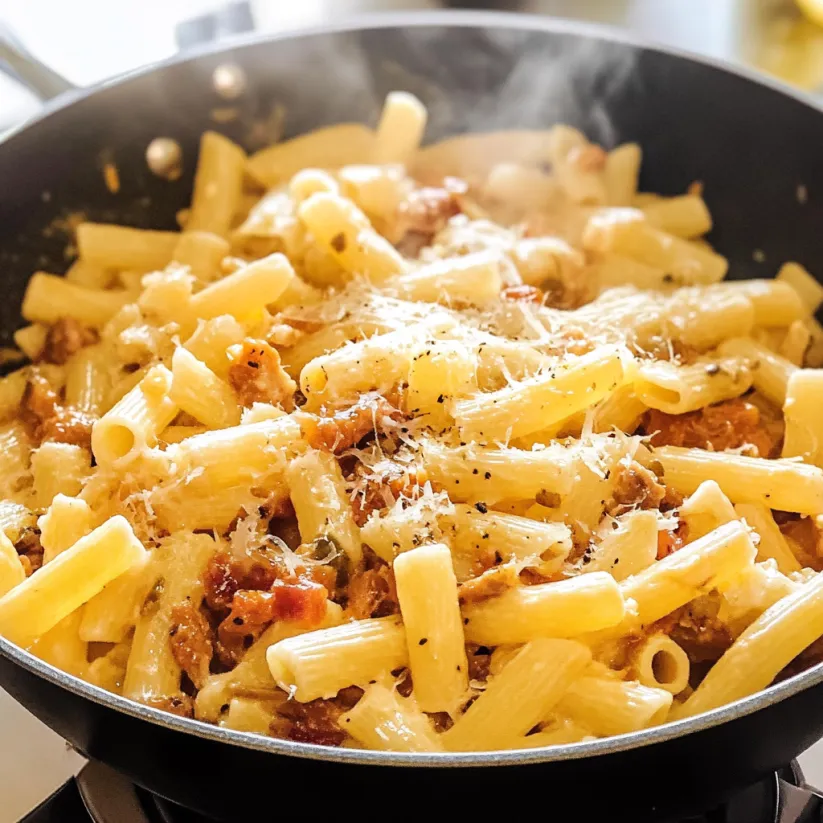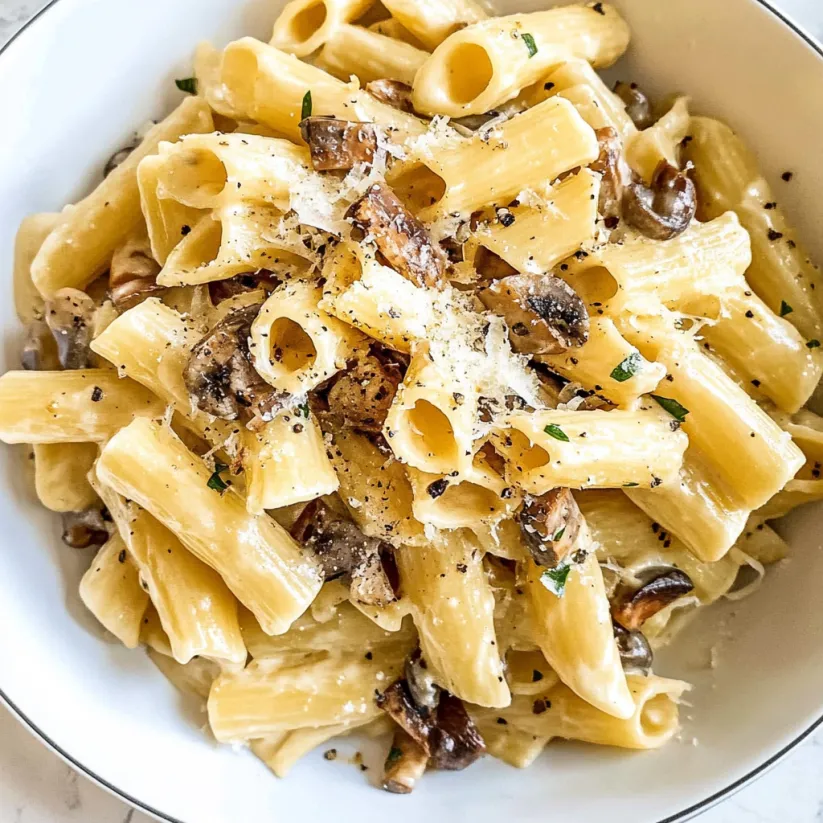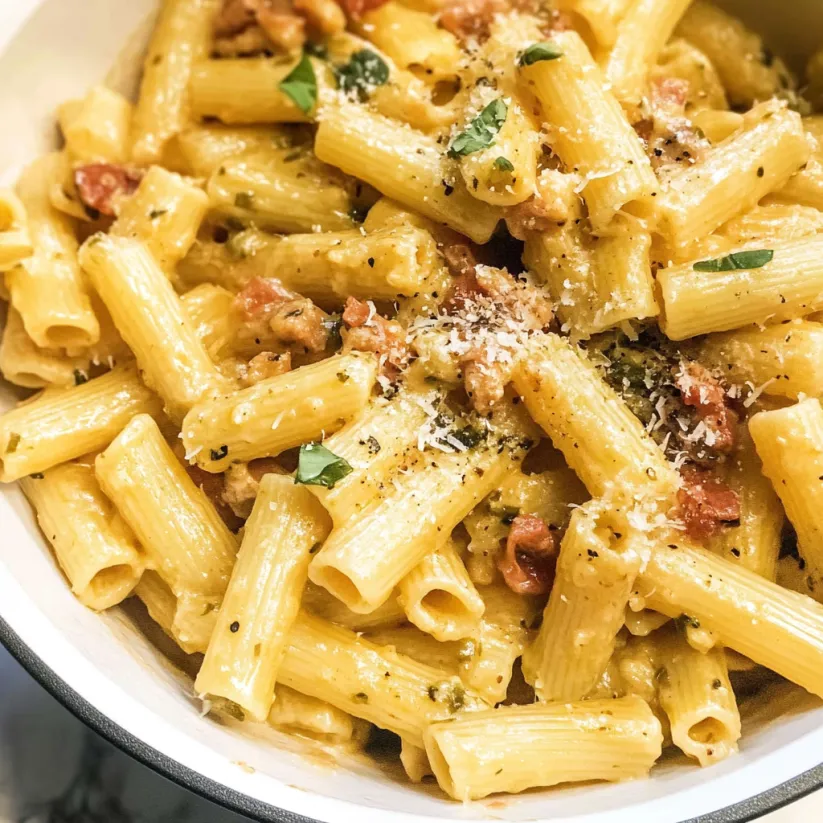 Save Pin
Save Pin
This savory 4-ingredient classic Italian Pasta Alla Gricia recipe is full of so much delicious flavor as perfectly rendered guanciale and Pecorino Romano cheese come together to make a sauce with freshly ground black pepper. It's a 20-minute meal that is simplicity at its best and a perfect example of why Italian cuisine is known for taking simple ingredients and turning them into iconic dishes that are easy to make and layered in so much flavor.
I first made this pasta alla gricia during a trip to Rome years ago, learning from a local chef who swore by its simplicity. Now it's become my go-to dinner when I want to impress guests without spending hours in the kitchen.
Ingredients
- 12 ounces rigatoni or other small shaped dry pasta: The shape helps capture the sauce beautifully
- 8 ounces guanciale: Cut into ¼-inch pieces. This cured pork jowl is the heart of the dish with its rich flavor
- 2 teaspoons black pepper: Freshly ground. Always grind it fresh for maximum aroma
- 6 ounces Pecorino Romano cheese: Finely grated. Look for authentic PDO Pecorino for the true Roman experience
Step-by-Step Instructions
- Render the guanciale:
- Add guanciale pieces to a large skillet over medium heat and cook patiently for about 10 minutes until crispy and golden. The slow rendering process releases all the beautiful fat and flavor. Transfer the crispy bits to a plate but keep that liquid gold fat in the skillet. You need about 2 tablespoons of fat for the sauce.
- Boil the pasta:
- While guanciale cooks, bring well-salted water to a boil. Cook rigatoni until just al dente about a minute less than package instructions. Reserve 2 cups of starchy pasta water before draining the pasta. This starchy water is crucial for creating the silky sauce.
- Start the sauce:
- Add freshly ground black pepper to the rendered fat and toast for about a minute to release its aromatic oils. Pour in 1 cup reserved pasta water, turn heat to high, and reduce the liquid by half. This concentration creates the base of your sauce.
- Add the pasta:
- Transfer drained rigatoni to the skillet and toss thoroughly in the fat and water mixture. Add more reserved water if needed until pasta is completely coated in a glossy sauce. Keep stirring gently to help the sauce emulsify.
- Add half the cheese:
- Stir in half the finely grated Pecorino Romano until fully incorporated. The cheese should melt into the sauce creating a creamy consistency with a beautiful glossy shine. The starchy water helps the cheese incorporate smoothly.
- Add the guanciale:
- Return the crispy guanciale to the pasta and toss to distribute evenly throughout the dish. This ensures every bite has the perfect balance of chewy pasta, tender meat, and silky sauce.
- Finish with cheese and serve:
- Garnish with remaining Pecorino and an extra crack of black pepper. Serve immediately while hot and enjoy this classic Roman specialty at its peak perfection.
 Save Pin
Save Pin
You Must Know
Authentic Roman dish dating back centuries Considered the predecessor to carbonara but without eggs Perfect weeknight dinner you can memorize easily
The first time I served this to my Italian father-in-law, he closed his eyes in appreciation with the first bite. The way the rendered fat from proper guanciale coats each piece of pasta creates a luxurious experience that belies how few ingredients are actually in the dish. That moment cemented this recipe as a family tradition.
The Secret of Guanciale
Guanciale is the traditional meat for this dish, but it can be challenging to find outside of specialty shops. While pancetta makes an acceptable substitute, the flavor profile is different. Guanciale comes from the pork jowl or cheek and has a more intense flavor with a higher fat content, which creates that silky sauce we're looking for. If you can find it, the distinctive flavor is worth the effort for an authentic experience.
Cheese Selection Matters
When making Pasta alla Gricia, using the right cheese significantly impacts the final dish. Pecorino Romano has a sharp, salty flavor that perfectly complements the richness of the guanciale. Avoid substituting with Parmigiano Reggiano in this recipe as it changes the authentic Roman character of the dish. Always grate your cheese finely and freshly before adding it to the pasta for the smoothest incorporation into the sauce.
The Roman Pasta Trinity
Pasta alla Gricia belongs to the famous Roman pasta trinity, alongside Cacio e Pepe and Amatriciana. Gricia is actually considered the predecessor to Amatriciana (which adds tomatoes) and Carbonara (which adds eggs). Understanding this relationship helps appreciate how Romans maximize flavor from minimal ingredients. This historical context explains why these simple pasta dishes remain beloved classics that have stood the test of time.
Perfect Pasta Water
The starchy pasta water is perhaps the most underappreciated ingredient in this recipe. It contains the dissolved starches from the pasta and acts as the emulsifier that brings the fat and cheese together into a cohesive sauce. Make sure your pasta water is properly salted (it should taste like the sea) and never rinse your pasta after cooking. That starchy exterior is crucial for helping the sauce cling to each piece of pasta.
 Save Pin
Save Pin
Commonly Asked Questions
- → Can I substitute guanciale with another ingredient?
Yes, you can substitute guanciale with pancetta as mentioned in the instructions. Bacon can also work in a pinch, though it will alter the flavor profile somewhat. For the most authentic experience, guanciale is preferred as it has a distinctive richness that defines the dish.
- → Why is pasta water important in this dish?
The starchy pasta water is crucial as it helps create the silky, emulsified sauce when combined with the rendered fat and cheese. It contains starches that act as a natural thickener and helps the sauce cling to the pasta while adding a subtle depth of flavor.
- → What's the difference between Pasta Alla Gricia and Carbonara?
While both are Roman classics using guanciale and Pecorino, Carbonara includes eggs which create its signature creamy sauce. Pasta Alla Gricia is often considered Carbonara's predecessor, using only guanciale, black pepper, Pecorino, and pasta water for its sauce.
- → What pasta shape works best for this dish?
Rigatoni is traditional and works wonderfully as its ridges and hollow center capture the sauce perfectly. Other good options include bucatini, spaghetti, or mezze maniche. Short pasta with ridges or texture generally works better than smooth shapes as they hold the sauce better.
- → Why shouldn't I add salt to the sauce?
Additional salt isn't needed because the dish already contains three salty components: the well-salted pasta water, the cured guanciale, and the aged Pecorino Romano cheese. Adding more salt would likely make the dish too salty and unbalanced.
- → How do I know when the guanciale is properly rendered?
Properly rendered guanciale should be golden and crispy, with most of its fat released into the pan. This typically takes about 10 minutes over medium heat. The slow rendering process is essential as it extracts the maximum flavor from the guanciale, which forms the foundation of the sauce.
